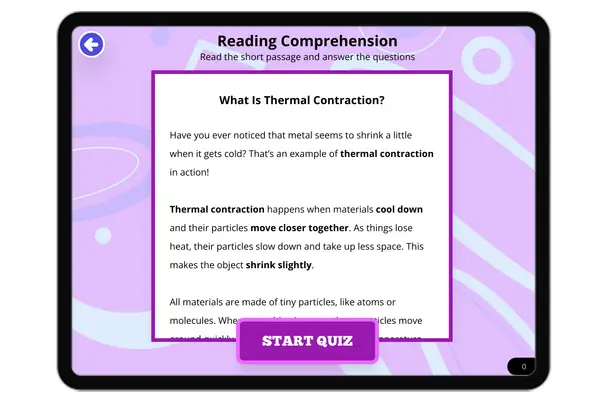What Is Kinetic Energy? — Passage
Kinetic energy is the energy of motion. Any object that is moving has kinetic energy, whether it’s a flying bird, a bouncing basketball, or a speeding train. The faster an object moves, the more kinetic energy it has. Mass also matters—heavier objects have more kinetic energy if they’re moving at the same speed as lighter ones.
For example, think of a bowling ball and a tennis ball rolling at the same speed. Even though they move at the same pace, the bowling ball has more kinetic energy because it has more mass. If both were to hit a wall, the bowling ball would hit with greater force due to its higher kinetic energy.
Kinetic energy depends on two factors: the mass of the object and its speed. This means that if you double the speed of an object, its kinetic energy becomes four times greater! This is why cars traveling at high speeds are more dangerous in crashes—they have a lot more kinetic energy.
Kinetic energy can change into other forms of energy, too. When a car brakes, kinetic energy turns into heat due to friction between the tires and the road. When you slide down a slide, your potential energy at the top becomes kinetic energy as you move downward.
Understanding kinetic energy helps scientists and engineers design safer vehicles, build efficient machines, and even improve sports equipment. It’s one of the most important types of energy we see in everyday life.
Fun Fact: A cheetah can reach speeds of up to 70 miles per hour, making it the fastest land animal—and giving it a huge amount of kinetic energy when it runs!
What is kinetic energy?
Energy stored in objectsEnergy of motionEnergy from foodEnergy from sunlightWhich object has more kinetic energy if both are moving at the same speed?
A tennis ballA featherA bowling ballA balloonWhat two things affect the amount of kinetic energy an object has?
Weight and colorMass and speedHeight and temperatureSize and shapeIf you double the speed of an object, what happens to its kinetic energy?
It stays the sameIt doublesIt becomes four times greaterIt is cut in halfWhat happens when a car brakes?
Kinetic energy turns into lightKinetic energy turns into heatKinetic energy disappearsKinetic energy turns into sound onlyWhich situation shows kinetic energy changing from potential energy?
A book on a shelfA person climbing stairsA ball rolling down a hillA car parked in a garageWhy is kinetic energy important in car safety?
It helps cars go fasterIt keeps the car balancedIt shows how much heat a car usesIt helps understand the danger of crashesWhat can we learn from studying kinetic energy?
How to stop energy from movingHow to make sports equipment betterHow to grow plants fasterHow to change the color of objects










